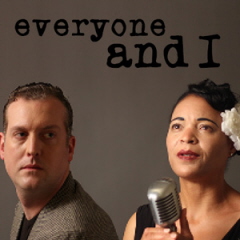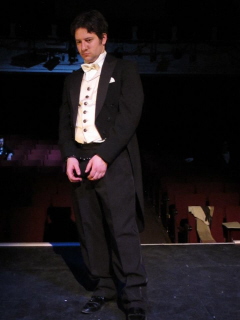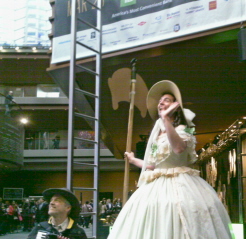The first week of the Philadelphia International Festival of the Arts (PIFA) had people lined up outside of the Kimmel Center to go through the interactive time tunnel that takes up much of the lobby. A point of picture destination is the crystals that pulse to your heartbeat and the musical Flash of Time by choreographer Myra Bazell has revolutionary soldiers, inventors, clowns, space cadets past present and not to mention a Mastodon and computer malfunction. There is no danger Will Robinson. Meanwhile some real life figures are providing some engaging theater.
Everyone And I
Hamilton Garden in the Kimmel Center
'Everyone And I' is part of the last line of a famous poem and if you remember the next line then you must not miss this play. The Azuka Theater and creative partner The American Poetry Review are debuting Elisabeth Scanlon's poetically poignant theater piece is premiering in the glass-vaulted Hamilton Garden. Scanlon an editor at APR brings to life poet Frank O'Hara and jazz singer Billie Holiday in intertwining narratives about how O'Hara came to write his most famous poem The Day Lady Died.
The players occupy the same stage, but are in different worlds. Holiday debriefs on how she took the money and kept quiet about her infamously ghost written memoir Lady Sings the Blues, her beginnings as a prostitute, how she became a singer because she couldn't dance. Her artistry and her bad luck with men, drugs and show business. Kimberly S. Fairbanks doesn't sing, but otherwise projects the Holiday's depth and peerless aura. She wears a gorgeous, low-cut, champagne hourglass satin cocktail gown, perfect gardenia in her hair completes the iconic picture.
Holiday mocks her persona as a hard-luck chanteuse, and flashes poses of two of the most iconic photos taken of her. The vivacious jazz diva, with gardenia in her hair and eyes cast up and next the bent over wreck, hair pulled back, face ashen and grim, hands clutching a rocks glass. O'Hara similarly jokes about his image and the trials of living an insular writer's life. Like Holiday, he is also part of a minority group expressing themselves in a repressive society. He relates how grand the gay life if, but dealing with the reality that being visible could mean getting arrested. Kevin Glaccum directs these actors with a light hand, reflecting Scanlon's script that never lets them over dramatize.
Mike Dees is just as dynamic as O'Hara, not to give anything away, when he eventually recites the poem, it is so logically connected to Scanlon's portrait of these two artists. Holiday died at age 44 and was an icon in decline and O'Hara was on the rise as curator at the Museum of Modern Art and becoming one of the poets of his generation. He talks about why he has to write every day and about his affair with the married with children Larry Rivers, and about being in the closet, but on the make as a 34-year-old gay man in New York in the 50s.
The Life (and death) of Harry Houdini
Plays and Players Theater
Brenna Geffers wrote and directed The Life (and death) of Harry Houdini as part of EgoPo Theatre's American Vaudeville Festival. Geffers is a specialist in bygone theatrical eras; the beaux-arts trappings of Vaudeville are brought to eerie life not only by the claptrap theatrics of Houdini, but by setting the play in the entire house of Plays and Players Theater on Delancey Street. The inventive set design by Doug Greene has the audience seated on tiers upstage and the action of the play on the stage skirt and in the empty house. It is a backstage perspective to tell the very theatrical story of Houdini's act, his life and his obsessions onstage and off.
The 75-minute play tracks Houdini's life from his modest beginnings in the mid-west, the son of a "failed" Rabbi and his wife, the family moves to New York, where Harry and his brother Dash try to break into show business as a team, instead of working in the garment district, the only trade that was welcoming to Jews. The brothers have modest success, but are competitive. Dash (for dashing) squires around the prettiest of a singing sister act, but Houdini wins her heart. The brother team breaks up & Houdini and his new wife (no justice would marry them because she was Catholic, he Jewish. But as Harry proclaims, "no piece of paper" need tell him they are married.
Houdini starts to take off as he moves from card and hankie tricks to the master of escape. After several years, he is headlining on the Orpheum Circuit and expanding his fame to Europe. He starts to devise more dangerous escape tricks of suspension and submersion. Haunted by memories of his dead father and paranoid about loosing his mother, Houdini is a bundle of self-doubt. When his mother does die, he can't accept it and he spares no expense to contact her through medium, but soon becomes disillusioned and exposes every fraud in his path. Houdini's famous demise looms over the back half of the play.
Robert DaPonte has the bottled energy (and that dark gaze) for a formidable incarnation of Houdini. He rushes his dialogue a bit, but is otherwise completely charismatic. Griffin Stanton-Ameisen's Dash is a pitch-perfect performance, destroyed at the death of his parents or hiding behind his intensely suave backstage lothario bit. The ensemble could be tighter with there lines, owing to all the stage business would be my guess. Geffers uses cabaret devises and physical theater mis-en-scenes to advance the story. Meanwhile, the cast is ever nimble with those trunk, straitjacket and cuff tricks.
Wide Awake: A Civil War Cabaret
Innovation Studio, Kimmel Center
photo:LW
The Bearded Ladies cabaret troupe travels from its Weimar Republic German roots, where the Ladies reimagined Metropolis and Marlene Deitrich to the ghosts the Confederate South. Only Jarboe's maniacally surreal mind could imagine for Wide Awake: A Civil War Cabaret, an off the hook PIFA centerpiece ensconced in their lower- level Innovation Studio, rather ingeniously to accommodate a dilapidated façade of a house and a Dixieland band. Whether you are there for the period drag, or the songs or the political humor, The Beardeds- Kristen Bailey, Oona Curley, Liz Filios, Jenna Horton and musical director Heath Allen, take no prisoners.
Jarboe appears regularly around Philly in performance as Edith Piaf and then there are those James Bond sex parodies by the Beardeds at the Wilma Theater. The Ladies are not only talented singers and comic actors, they put political satire back in cabaret.
John Jarboe is a 9- foot Scarlett O'Hara knockoff par excellence, just to hear her sing the medley of southern ditties that build to a climactic The Night They Drove of Dixie Down would put Rhett in the corner. The long set up of Dixie, being released from her excavated mansion and the ghost busters banter could easily be trimmed, but by the time James Ijames is leading a Love Train as Lincoln and hearing Filios' Walt Whitman, a tie-stick dropping out of her beard, singing Gimmie Shelter, there is no escape, and who would want to.
